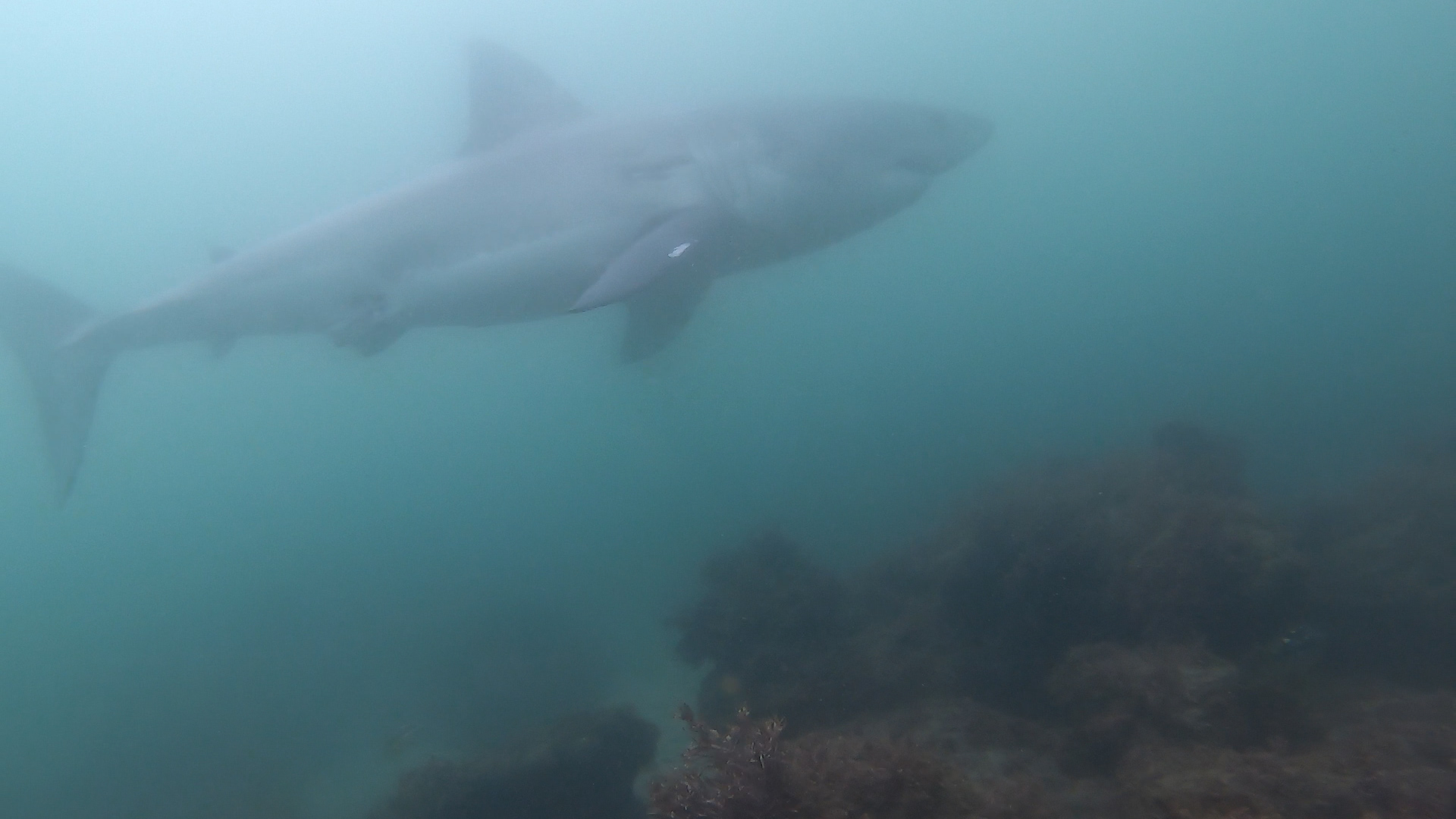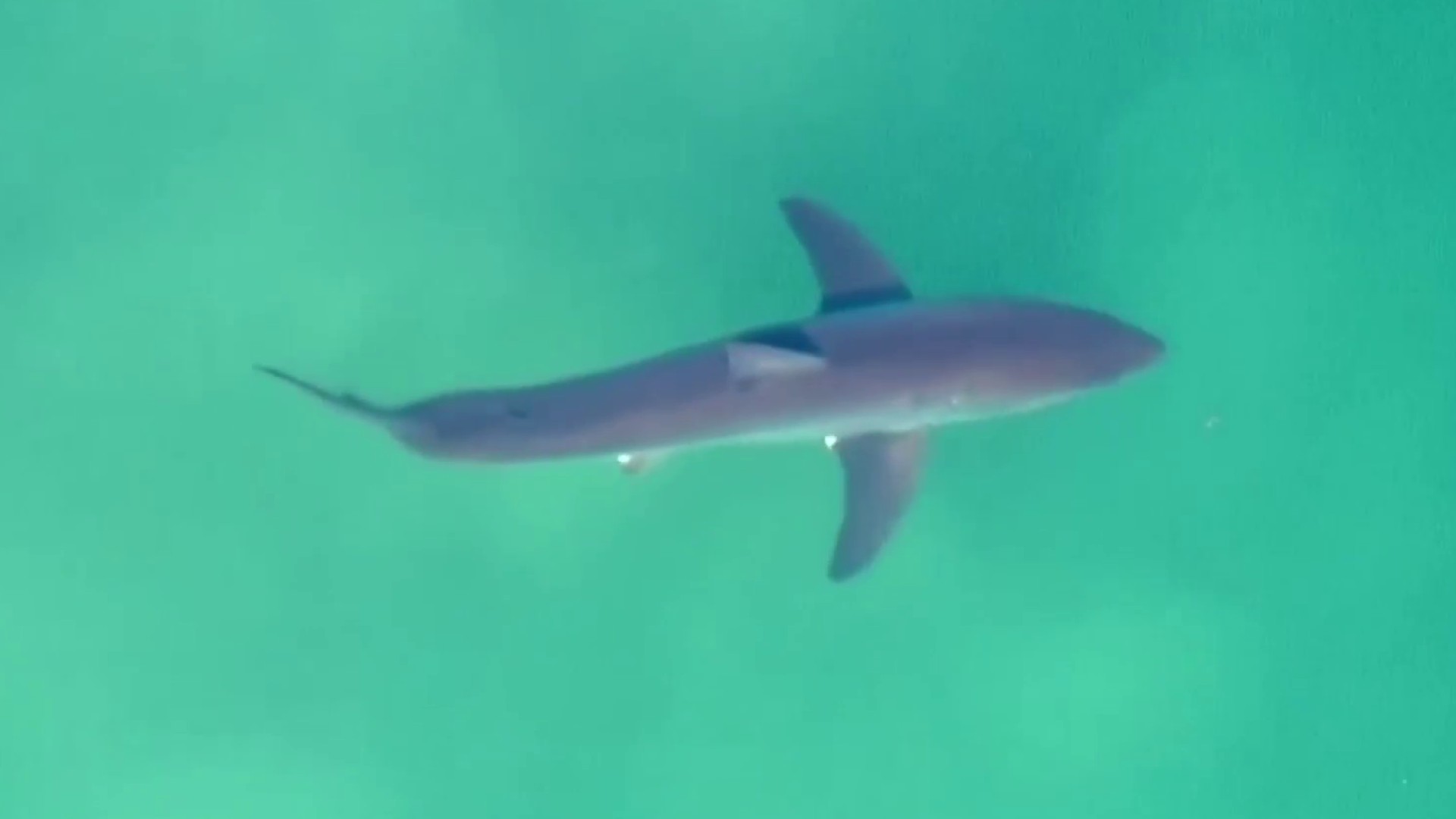Biting tuna and flowing beer. That's about all you can ask for on a 12-hour sportfishing charter. But the coolest part of a recent angling excursion for a group of San Diego sons and fathers was their run-in with a fish they wouldn't dare to try and catch: a great white shark.
Sportfishing crews are taught to look out for commotion in the open water: diving birds, splashing fins or any other disturbances in the gentle lapping of ocean currents. When deckhand Ethan Hougie, perched high on the King Triton's tuna tower, spotted some wrestling and a pool of perfect crimson growing in the distance, he directed the boat towards it.
As he approached, he realized they were late for lunch.
The crimson pool staining the deep blue ocean was the blood of a seal or sea lion, or half of one. The carcass was being devoured by a white shark one very large bite at a time.
"Get me right over it," Hougie ordered to somebody at the helm.
"It's eating. Oh my — That's the biggest one I've seen out here, for sure," he said, recording his approach on his cell phone.
"Neutral right here. I want to watch this thing eat."
Just feet away now, the shark was submerged. The floating carcass was big and meaty but appeared to be missing its head and tail, making identification a challenge. Seconds later, there was even less of it to look at.
"It's right behind it! Look at the size of that thing, dude!" Hougie shouted. Just as he was finishing his thought, the shark poked its snout out of the water and chomped down on the carcass once again.
"OOOOHHHHHH!" belted a chorus of fishermen. Profanity followed, naturally.
The King Triton was about 14 miles off the coast of Mission Bay on hour 5 or 6 of their half-day charter. They spent about a half-hour watching nature take its course, a scene one client described as beautiful and peaceful.
Sharks in San Diego
"Jaws makes us afraid of sharks, Shark Week makes us afraid of sharks. Granted, I wouldn't want to be in the water with it, but watching it was really beautiful," environmental educator Sustainable Shane said.
"That was the first time I've really been aware of how big the jaws are of a shark," Hougie said. Hougie owns California Sportfishing Company but was hired to captain the Triton for this charter trip. After taking a couple of videos of the shark, Hougie said he made sure to try and take it all in.
"When we catch 200-pound tuna, it's like you waited all day and finally here it is. If you don't sit back and enjoy it, that moment's going to -- a 20-minute moment with that shark is going to go away pretty quick," he said. "I was just sitting back waiting for that thing to come back from the shadows and take another bite out of the sea lion, and every time I was like, 'Holy sh-- here it comes! Here it is! Oh my goodness! Here it is! Boom!'"
Hougie said he's seen orcas play catch with porpoise — Whales essentially beat them into submission with their tales and fins, sometimes launching them dozens of feet in the air. Look it up on YouTube. It's nuts. But he said his front-row seat to this shark's feast was by far the coolest thing he's seen out on the water.
The same goes for Coopersmith, who's seen his share of cool stuff in nature as a diver, spear fishermen and cast member on season 8 of Bravo's "Below Deck."
"It was for sure the most gory thing I've ever seen in my life ... This was just full-on intestines floating, the gnarliest things you could see were the giant shark jaws had latched into the sides of the sea lion and then ripped out a bite. And you could see the tooth marks and where the blubber fits in between the jagged teeth," he said. "I've watched sea lions give birth and other amazing things in nature, but watching this great white shark eat was more beautiful than intense and scary."
Coopersmith estimated the shark was 16 feet, while Hougie was sure it was longer than 20. Dr. Christopher Lowe, director of the Shark Lab at California State University, Long Beach, said the shark was more like 13 feet, using the 35-foot boat and the humans at its stern for scale.
Lowe was certain the shark was female, citing its clear lack of claspers, which are sperm-delivering appendages located underneath the fins of male sharks.
"This female was right where she was supposed to be," according to Lowe. At this time of year, females are making their way back from the waters between California and Hawaii to give birth. The males typically head to the Channel Islands or further north to feed on elephant seals.
Lowe said King Triton's encounter is evidence of several positives, but he also pointed out that it helps debunk some myths about sharks.
First, Lowe said, people should remember that although white sharks feed on seals and sea lions, the same cute, blubbery animals you see on the rocky shores of La Jolla, that doesn't mean white sharks are just waiting in the shallows.
"That’s what we’ve been trying to tell people in San Diego. We know they’re offshore, but they’re not just swimming off the beach," he said. "Sea lions cover a lot of ground, swimming in the ocean miles off the coast. Just because a seal that has been bitten comes on the beach, it doesn’t mean it was bitten close."
And an encounter like this one is a positive sign for the health of the species, according to Lowe. They are becoming more common, and Lowe credits state protections for white sharks and their food sources in the mid-90s for helping to rejuvenate those populations. But while there are more sharks in the water, "There's no indication a growing population is an increased threat to humans."
For now, that is.
"We haven’t seen an increase in incidents, but climate change could change everything," Lowe said. "Right now, the population seems to be doing well. Twenty years from now, that could be a whole other issue. It might get to the point where it’s no longer beneficial. We just don't know how climate change is going to affect the population."
Another interesting fact from Lowe is that white sharks aren't often successful when trying to hunt seals and sea lions. Yea, seals and sea lions are blubbery, but they're more evolved than sharks, they have big brains and are highly maneuverable mammals (to the surprise of many who have only seen them sunbathing at the Children's Pool), Lowe said. And while white sharks have physiological adaptations that make them closer to mammals and help them hunt mammals, they're still prehistoric fish. A white shark wouldn't waste its energy chasing a fast seal.
"Sharks have to be very sneaky to catch them by surprise," Lowe said, "And that's why so many make it back to the beach with bite marks and injuries."
Editor's note: A previous version of this story incorrectly identified Hougie as a hired captain on the King Triton charter. Hougie was a hired deckhand for this trip. King Triton SportFishing's captain, owner and operator is Ian Pellegrini.



